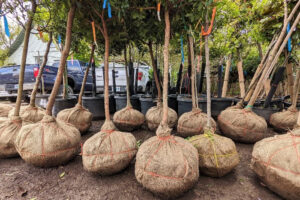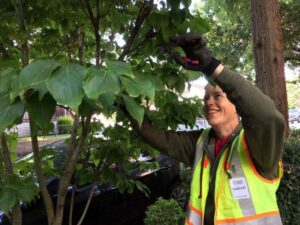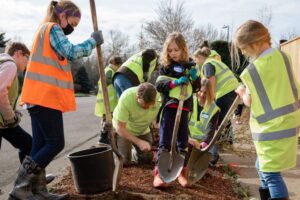Preparing Eugene Trees for Climate Change
What we can do in the face of an uncertain future
When it comes to trees, there are so many layers to preparedness, from the near to distant future, from the next heat wave or ice storm to what the climate might look like in 25 years. So much of the future is uncertain, but there’s plenty you can do to prepare your trees for what they might encounter.
“So much is unknowable,” says Eugene Director Erik Burke. “You won’t have the information you need to make your decisions when you make them. You just have to make your best guess.”
The very first decision you’ll make is what tree to plant. Considering trees that are adapted to your climate, and what the climate might be in the future, can set your tree up for a long, healthy life.
“For a while, the estimate was that by 2050, Eugene’s climate might be like Sacramento’s is now,” Erik says. “But that estimate is moving even further south to Stockton.”

Erik outlines three approaches that planting programs can take to prepare for climate change. The first is diversity for diversity’s sake. Planting a variety of trees means that if any particular species fails due to climate impacts or disease, it won’t take out a huge chunk of the urban forest. The second is very intentionally looking at trees adapted to our native climate and soils, but many of those species aren’t readily available in the nursery trade. The third is planting broadly adapted trees with huge ranges, but many of those trees aren’t drought tolerant, and because many of those trees are clones, they aren’t given the opportunity to adapt from generation to generation.
“Really, we should do some of each approach,” Erik says. “There are trade offs for each.”
What about trees that are already in the ground? How do we prepare our large trees? Our Eugene Team always emphasizes the importance and value of regular pruning. Appropriate pruning will set a tree up to survive in the urban environment and in the face of weather events.
“It’s important to remember that stress is additive. Even if a tree survives, stress can pile up from heat wave to ice storm to heat wave.” Erik says. “That’s why we need to water during heat waves and prune properly after ice storms.”
How we respond to storms is the first step in preparing for the next one. Erik warns that bad pruning after an ice or wind storm can lead to more failure down the line, because limbs won’t be strong enough for the next. Still, he advocates for proper pruning after storm damage rather than removing a tree.
“When you remove a tree, you’re back to square one. But restorative pruning can give that mature tree a chance to continue providing benefits.”

Selection, siting, pruning, protecting soil, and public education. This is how we reach what Erik calls our ultimate goal: to have a healthy relationship with trees. That’s why it’s important to find opportunities to talk about trees.
“Weather and climate is something everyone experiences,” says Taylor Glass, Eugene-Springfield Program Manager. “It’s something to connect over. It’s a way to talk about climate change.”
“My hope is that it will cause us to cooperate more,” Erik says.
“We’re going to have to,” Taylor says.

